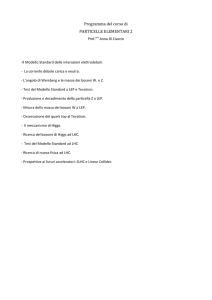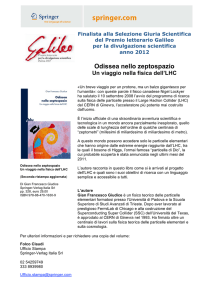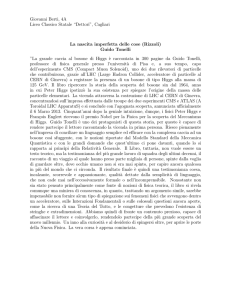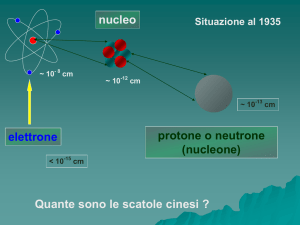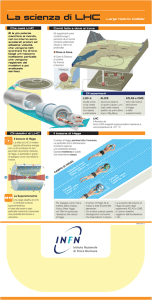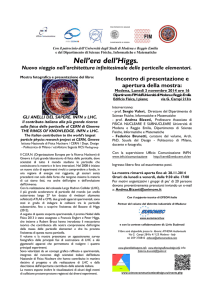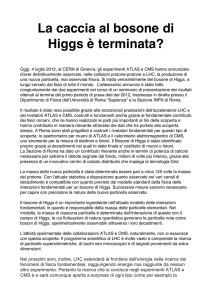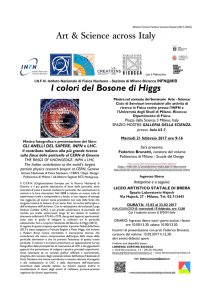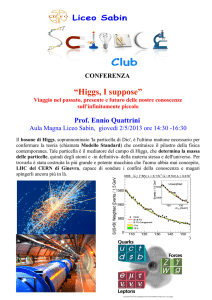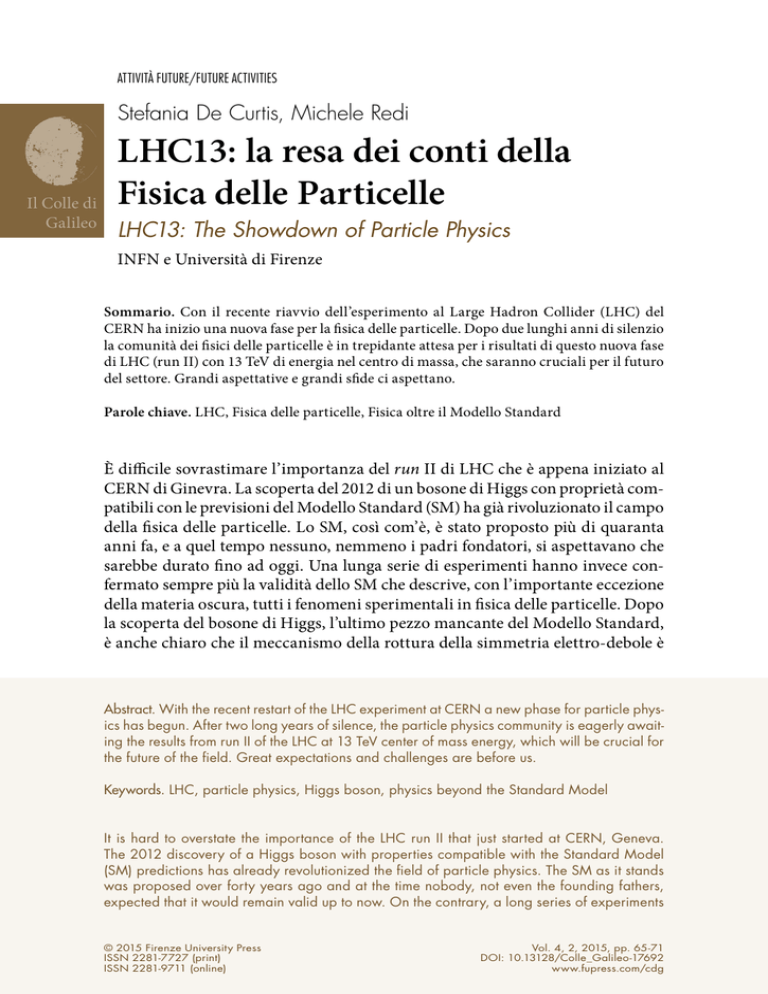
ATTIVITÀ FUTURE/FUTURE ACTIVITIES
Stefania De Curtis, Michele Redi
Il Colle di
Galileo
LHC13: la resa dei conti della
Fisica delle Particelle
LHC13: The Showdown of Particle Physics
INFN e Università di Firenze
Sommario. Con il recente riavvio dell’esperimento al Large Hadron Collider (LHC) del
CERN ha inizio una nuova fase per la fisica delle particelle. Dopo due lunghi anni di silenzio
la comunità dei fisici delle particelle è in trepidante attesa per i risultati di questo nuova fase
di LHC (run II) con 13 TeV di energia nel centro di massa, che saranno cruciali per il futuro
del settore. Grandi aspettative e grandi sfide ci aspettano.
Parole chiave. LHC, Fisica delle particelle, Fisica oltre il Modello Standard
È difficile sovrastimare l’importanza del run II di LHC che è appena iniziato al
CERN di Ginevra. La scoperta del 2012 di un bosone di Higgs con proprietà compatibili con le previsioni del Modello Standard (SM) ha già rivoluzionato il campo
della fisica delle particelle. Lo SM, così com’è, è stato proposto più di quaranta
anni fa, e a quel tempo nessuno, nemmeno i padri fondatori, si aspettavano che
sarebbe durato fino ad oggi. Una lunga serie di esperimenti hanno invece confermato sempre più la validità dello SM che descrive, con l’importante eccezione
della materia oscura, tutti i fenomeni sperimentali in fisica delle particelle. Dopo
la scoperta del bosone di Higgs, l’ultimo pezzo mancante del Modello Standard,
è anche chiaro che il meccanismo della rottura della simmetria elettro-debole è
Abstract. With the recent restart of the LHC experiment at CERN a new phase for particle physics has begun. After two long years of silence, the particle physics community is eagerly awaiting the results from run II of the LHC at 13 TeV center of mass energy, which will be crucial for
the future of the field. Great expectations and challenges are before us.
Keywords. LHC, particle physics, Higgs boson, physics beyond the Standard Model
It is hard to overstate the importance of the LHC run II that just started at CERN, Geneva.
The 2012 discovery of a Higgs boson with properties compatible with the Standard Model
(SM) predictions has already revolutionized the field of particle physics. The SM as it stands
was proposed over forty years ago and at the time nobody, not even the founding fathers,
expected that it would remain valid up to now. On the contrary, a long series of experiments
© 2015 Firenze University Press
ISSN 2281-7727 (print)
ISSN 2281-9711 (online)
Vol. 4, 2, 2015, pp. 65-71
DOI: 10.13128/Colle_Galileo-17692
www.fupress.com/cdg
66
Stefania De Curtis, Michele Redi
almeno approssimativamente corretto. Nonostante questo enorme successo, da
oltre 30 anni molte estensioni dello SM, motivate soprattutto dal desiderio di naturalezza della teoria, sono state proposte dai fisici teorici. Nel vasto panorama
di modelli ben motivati di nuova fisica, solo pochi rimangono plausibili dopo il
primo run di LHC, in particolar modo la supersimmetria e modelli di Higgs composto. Altre proposte, molto popolari, come le teorie formulate in extra-dimensioni, i vecchi modelli di technicolor, le teorie Higgs-less, non sono sopravvissute
al giudizio degli esperimenti, e altri modelli sono sempre più sotto pressione a
causa dei risultati sperimentali che confermano lo SM.
Con l’aumento di energia a 13 TeV nel run II, la situazione è destinata a diventare ancora più drammatica. LHC sarà in grado di testare scenari per la fisica oltre lo SM in dettaglio e di sondare l’esistenza di nuove particelle previste da
estensioni dello SM a un livello senza precedenti. I limiti attuali, anche se stringenti, non sono ancora conclusivi e non escludono completamente scenari naturali alla scala di Fermi, ma la situazione diventerà più chiara durante l’attuale
run di fisica a LHC. A titolo di esempio, dalla supersimmetria i limiti di massa
sui partener supersimmetrici del quark top (stops) sono di circa 500 GeV, un valore ancora compatibile con una teoria naturale della scala elettro-debole. Allo
stesso modo, top partner fermionici di modelli di Higgs composto sono esclusi
fino a circa 700 GeV. Con LHC a 13 TeV si ha accesso a scale di massa che sono
almeno il doppio di quelle dei limiti attuali.
Dal punto di vista teorico la domanda principale che avrà una significativa
risposta da LHC nei prossimi anni riguarda la naturalezza dello SM. Per diversi
have increasingly confirmed the validity of the SM which, with the notable exception of dark
matter, describes all experimental phenomena in particle physics. After the discovery of the
Higgs boson, the last missing piece of the SM, it is also clear that the picture of electro-weak
symmetry breaking is at least approximately correct. Despite this enormous success for over
30 years many extensions of the Standard Model, motivated especially by the desired naturalness of the theory, have been proposed by theorists. In the vast panorama of motivated
new physics models, only a few, most notably supersymmetry and composite Higgs models,
remain plausible after the first run of the LHC. Many other popular proposals, such as large
extra-dimensions, old-fashioned technicolor models and Higgs-less theories did not survive
the verdicts of the experiments. The remaining ones are under increasing pressure from the
experimental results.
With the energy increase to 13 TeV for run II, the situation is bound the become even more
dramatic. The LHC will be able to test scenarios for physics beyond the SM more extensively,
probing the existence of new particles predicted by extensions of the SM to an unprecedented
level. Despite being stringent, the current bounds, are not yet conclusive, and do not completely exclude natural scenarios for the Fermi scale, but this situation will become clearer during
the present physics run of the LHC. To take an example from supersymmetry, the mass limits
on stops from run 1 are around 500 GeV, a value still compatible with a natural theory of the
electro-weak scale. Similarly, fermionic top partners of composite Higgs models are excluded
up to around 700 GeV.
Stefania De Curtis, Michele Redi
LHC13: la resa dei conti della Fisica delle Particelle
Figura 1. La fisica delle particelle è a un bivio.
Figure 1. Particle physics is at a crossroads.
decenni la ricerca nel campo della fisica delle particelle è stata guidata dal principio della naturalezza, ovvero l’idea che i parametri della teoria dovrebbero
avere valori che non richiedono cancellazioni precise (tuning). Questo principio afferma che non si dovrebbe ottenere 1 in un calcolo a causa di una cancellazione accidentale di due numeri di ordine un miliardo o più. Applicato alla
fisica delle particelle, il principio di naturalezza richiede l’esistenza di nuove
The LHC at 13 TeV will probe mass scales that are at least twice as high as the current limits.
From the theoretical point of view the main question that will be significantly answered by the LHC
in the next few years is about naturalness. For several decades the field of particle physics has
been driven by the principle of naturalness: the idea that parameters of the theory should have
values that do not require precise cancellations, or tuning. This principle states that you should
not get 1 in a computation out of an accidental cancellation of two numbers of the order a billion
or more. Applied to particle physics naturalness requires the existence of new particles around
the TeV scale. This is extremely exciting since these energies can be probed at the LHC. If the
theory is natural in the conventional sense described above, new particles must exist below the
TeV scale. The principle at stake is a strong one and has worked successfully in almost all physical systems that we know of, but it is not a mathematical theorem. In fact our idea of naturalness
has very probably failed at least once: for the cosmological constant found to be much smaller
than its natural value. If the paradigm of naturalness fails it will be a revolution in itself. Indeed,
discovering that the Higgs mass behaves like the cosmological constant will immediately suggest
the possibility that the parameters of the theory are determined by environmental conditions. This
would require the existence of a scenario of different worlds with completely different values of
parameters and even particles. The discovery that we live in a multiverse would be the ultimate
Copernican revolution: not only do we live in a corner of the universe, rotating around a modest star, we also live in a patch within an infinite number of parallel universes. Unfortunately it is
far from clear how we could ever convincingly test this hypothesis, going beyond science fiction.
LHC13: The Showdown of Particle Physics
67
68
Stefania De Curtis, Michele Redi
particelle intorno scala del TeV. Ciò è estremamente eccitante visto che queste
energie possono essere sondate da LHC. Se la teoria è naturale, nel senso convenzionale descritto sopra, nuove particelle devono esistere al di sotto della scala del TeV. Il principio in gioco è molto solido ed è stato applicato con successo
in quasi tutti i sistemi fisici che conosciamo, ma non è un teorema matematico. In realtà la nostra idea di naturalezza è molto probabilmente fallita almeno
una volta. Infatti la costante cosmologica risulta essere molto inferiore al suo
valore naturale. Se il paradigma di naturalezza fallirà questa sarà comunque
una rivoluzione per sé. Infatti se scoprissimo che la massa del bosone di Higgs
si comporta come la costante cosmologica, ciò suggerirebbe immediatamente
la possibilità che i parametri della teoria possano essere determinati dalle condizioni ambientali. Questo richiederebbe l’esistenza di universi multipli con
valori completamente diversi dei parametri e anche con particelle diverse. La
scoperta che viviamo in un «multiverso» sarebbe l’ultima rivoluzione copernicana: non solo viviamo in un angolo del nostro universo, ruotando attorno a
una stella modesta, ma viviamo anche in un universo di un numero infinito di
universi possibili. Purtroppo non è affatto chiaro come si possa mai verificare
in maniera convincente questa ipotesi.
Dal punto di vista sperimentale la situazione è molto semplice:
• scoperta: se vengono rivelate nuove particelle questo probabilmente accadrà
entro i primi 2 anni del run II di LHC. Ciò darebbe inizio a un periodo eccitante per la teoria e per gli esperimenti per determinare la natura delle nuove
scoperte. Il campo della fisica delle particelle rifiorirebbe;
From the experimental angle the situation is far simpler:
• discovery: If new particles are discovered this will probably happen within the first 2 years
of the LHC run II. This would launch an exciting period for theory and experiments to determine the nature of the new physics discovered. The field of particle physics would flourish;
• no discovery: If no discovery or hints of new physics are seen early on, the LHC will enter a
long phase of more precise measurements that will test detailed features of the SM, Higgs
interactions in particular. It is less likely that new discoveries will be made during this period, and very probably they would not be conclusive. The field would be left without any
clear direction.
It is fair to say that at this stage any new discovery beyond the SM will come as a surprise
to most. After the discovery of the Higgs, the days of no-lose theorems (stating that either the
Higgs boson exists, or something even more exciting) are over. The SM with the Higgs is a
consistent theory potentially valid up to energies much greater than the ones we can conceivably test in laboratory experiments. Now that the tuning era has started, no guarantee exists
that new physics will be discovered in the foreseeable future. The failure to find any sign of
new physics, in experiments from flavor to precision tests and direct searches at LHC, has already shaken the belief that the electro-weak scale will ultimately turn out to be natural. From
the theory perspective, the discovery of new physics at this stage would definitely look like the
result of a compromise, sacrificing some attractive feature of the SM to solve another problem. There is no scenario on the market more successful than the SM in terms of experiments.
Stefania De Curtis, Michele Redi
LHC13: la resa dei conti della Fisica delle Particelle
• nessuna scoperta: se nessun accenno di nuova fisica sara’ presto visibile, LHC
entrerà in una lunga fase di misurazioni più precise che studieranno le caratteristiche dettagliate delle interazioni dello SM e del bosone di Higgs in particolare. È meno probabile che ci siano nuove scoperte in questo periodo, e in
ogni caso non sarebbero conclusive. La fisica fondamentale rimarrebbe senza
una direzione chiara.
È chiaro che in questa fase qualsiasi nuova scoperta di fisica oltre lo SM arriverà come una sorpresa per la maggior parte dei fisici. Dopo la scoperta del bosone
di Higgs la certezza di scoprire qualcosa di nuovo è svanita (i teoremi no-lose affermavano infatti che se non si fosse scoperto il bosone di Higgs allora si sarebbe manifestato qualcosa di ancora più eccitante). Lo SM con il bosone di Higgs è
una teoria coerente potenzialmente valida fino a energie molto maggiori di quelle
che possiamo plausibilmente testare in esperimenti di laboratorio. Non esistono
quindi garanzie che nuova fisica sia scoperta nel prossimo futuro. L’impossibilità
di trovare alcun segno di nuova fisica negli esperimenti sul sapore dei quark, nei
test di precisione o nelle ricerche dirette a LHC, ha già intaccato la convinzione
che la scala elettro-debole alla fine possa rivelarsi naturale.
Dal punto di vista teorico, la scoperta di nuova fisica in questa fase sarebbe
sicuramente il risultato di un compromesso: rinunciare a qualche caratteristica
attraente dello SM per risolvere il problema della naturalezza. Non esiste scenario che abbia più successo dello SM nel confronto con gli esperimenti. Se la supersimmetria o uno scenario di Higgs composto fossero scoperti, altre domande
sarebbero immediatamente sollevate: perché ora, perché così, chi ha ordinato que-
If supersymmetry or composite Higgs were discovered, other questions would immediately be
raised: Why now? Why in this way? Who arranged it?. We might even ask why the Lord has
chosen to make things so complicated, but we will not delve into this temptation.
Moreover, new physics scenarios accessible at the LHC predict deviations from SM predictions in many observables. There is definitely a clear tension between the lack of any deviation
from SM predictions in previous experiments, as well as recent LHC direct searches, and the
hope that new physics will be discovered in the current run of LHC. Avoiding current experimental bounds in scenarios such as supersymmetry demands a degree of theoretical tuning.
Such tuning is typically quantified as the measure of tuning that the parameters of the theory
must satisfy to avoid the experimental bounds. The tension however goes far beyond this mere
number. Once the SM is abandoned at scales accessible to the LHC as demanded by naturalness, automatic features of the SM, for example stability of the proton, are not granted and
some specific mechanism must be invoked for their validity.
Although the scenario described above seems very dark, all hope is not lost. After all, everything could change very rapidly: it would take only one new particle to overturn the status
of the entire field. It is possible that the theorists are mistaken, they have been wrong before.
Perhaps things are just a little tuned and LHC run II will reveal the first glimpses of the new physics. Another possibility is that naturalness is not the only correct guide and the electro-weak
scale is not natural since it is determined anthropically. If we abandon naturalness many new
physics scenarios can be imagined that are weakly constrained by previous experiments but
LHC13: The Showdown of Particle Physics
69
70
Stefania De Curtis, Michele Redi
sto? Ci si potrebbe chiedere: perché la Natura ha scelto di essere così complicata?
Inoltre scenari di nuova fisica accessibili a LHC prevedono scostamenti dalle
previsioni dello SM in molte osservabili. C’è sicuramente una tensione evidente tra la mancanza di qualsiasi deviazione dalle previsioni dello SM negli esperimenti precedenti, nonché da recenti ricerche dirette a LHC, e la speranza che
nuova fisica sia scoperta all’attuale run II di LHC.
Evitare i presenti limiti sperimentali in scenari come la supersimmetria richiede un certo grado di abilità dal punto di vista teorico. Questa abilità è tipicamente
quantificata nella precisione delle cancellazioni che i parametri della teoria devono soddisfare per evitare i limiti sperimentali. La tensione però va ben oltre questo semplice numero. Una volta che lo SM viene abbandonato a scale accessibili
a LHC come richiesto dalla naturalezza, le proprietà che sono automatiche nello
SM, come per esempio la stabilità del protone, non sono più garantite e dobbiamo
richiedere qualche particolare meccanismo per la loro validità.
Il quadro fin qui descritto sembra molto compromesso ma non tutte le speranze sono perse. Tutto potrebbe cambiare molto rapidamente; sarebbe sufficiente
scoprire una nuova particella per ribaltare lo stato dell’intero campo.
È possibile che i teorici si sbaglino. Si sono sbagliati altre volte in passato.
Forse l’aggiustamento di precisione dei parametri dello SM è di modesta entità e LHC run II farà intravedere i primi scorci di nuova fisica.
Un’altra possibilità è che la naturalezza non sia la sola giusta guida e che la scala
elettro-debole non è naturale in quanto determinata antropicamente. Se abbandoniamo la naturalezza possiamo immaginare molti scenari di nuova fisica che
could be discovered by moving to higher energy. The discovery that new physics is not related to naturalness would be a surprise in terms of the present theoretical bias, but it is entirely
possible and should not be overlooked. Such a discovery would be comparable to that of the
muon after the electron. Finally we should not forget that there could always be something
theorists haven’t considered.
To summarize: common sense says that no new physics will be found in the LHC run II.
Naturalness predicts that the Higgs boson comes with a wealth of new particles some of which
should be accessible to LHC. Experiments will be the judge. It is also conceivable that new
physics unrelated to the Higgs boson will be found. If nothing is found in the next two years,
we have no idea when it could possibly appear.
Stefania De Curtis. Senior Researcher at the INFN and lectures as an adjunct professor on the
course of Field Theory II for the MSc in Physics of the University of Florence. She is currently
coordinator of the Florence INFN theoretical group. Her research deals with elementary particle physics and theories of fundamental interactions. Michele Redi. Junior Researcher at INFN, Florence. He studied at the University of Florence
and received a PhD from Johns Hopkins University before holding positions at New York University, EPFL and CERN. His research ocuses on Physics beyond the Standard Model of elementary particles.
Stefania De Curtis, Michele Redi
LHC13: la resa dei conti della Fisica delle Particelle
sono debolmente limitati dai precedenti esperimenti, ma che potrebbero essere
scoperti andando a più alta energia. La scoperta di nuova fisica non connessa con
la naturalezza sarebbe una sorpresa in quanto devierebbe dal pregiudizio dominante, ma è del tutto possibile e non deve essere trascurata. Tale scoperta sarebbe
paragonabile a quella del muone dopo l’elettrone. Infine, non dobbiamo dimenticare che ci potrebbe essere sempre qualcosa a cui i teorici non hanno pensato.
Per riassumere: il buon senso dice che nessuna nuova fisica si manifesterà nel run
II di LHC. Il principio di naturalezza prevede invece che il bosone di Higgs debba
essere accompagnato da nuove particelle, alcune delle quali dovrebbero essere accessibili a LHC. Gli esperimenti daranno la risposta. È anche possibile che si scopra nuova fisica estranea al settore di Higgs. È comunque vero che, se niente verrà
scoperto nei prossimi due anni, non abbiamo idea di quando potrebbe apparire.
Stefania De Curtis. Prima Ricercatrice dell’INFN e docente del corso di Teoria dei
Campi II della Laurea magistrale in Fisica come professore a contratto dell’Università di Firenze. È attualmente coordinatrice del gruppo teorico della sezione
INFN di Firenze. La sua ricerca si colloca nel settore della fisica delle particelle
elementari e teorie delle interazioni fondamentali.
Michele Redi. Ricercatore nella sezione INFN di Firenze. Si è laureato all’Università di Firenze e ha ottenuto il dottorato di ricerca dell’Università Johns Hopkins
prima di posizioni alla New York University, EPFL e CERN. La sua attività di ricerca è incentrata sulla Fisica oltre il Modello Standard delle particelle elementari.
LHC13: The Showdown of Particle Physics
71

